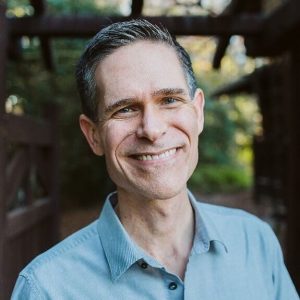
4 Takeaways for Christian Youth Leaders from the 2023 State of Religion & Young People Report
Springtide’s mission is to listen and understand the distinct ways young people express community, identity, and meaning. While we craft actionable insights based on that research, we look to others directly invested in working with young people to help make our insights tangible and actionable in their contexts.
Fuller Youth Institute (FYI) specializes in creating resources for Christian youth ministry leaders that help equip young people for lifelong faith. Here, Brad M. Griffin, director of content for FYI, offers a reflection on our upcoming report, The State of Religion and Young People 2023: Exploring the Sacred, and how Christian youth leaders can implement its insights
Who cares about the sacred, anyway?
Certainly not young people. Aren’t they cynical—hardened by surviving the pandemic and coming of age in a digital world designed to profit as much from their interests as their mistakes? Don’t they mistrust religion, disdain institutions, and generally disbelieve adults?
While some of our assumptions about young people may be accurate (for example, 75% of respondents say they distrust organized religion), what this year’s State of Religion and Young People report from Springtide Research Institute suggests is that young people are also open to holy encounters.
In other words, this generation is inviting us to listen. Here are four takeaways from the report, particularly for Christian youth ministry leaders.
1. Young people often find God in thin places.
Sacred moments are personal, relational, and extraordinary—and everyone has them. This might raise questions for those of us in youth ministry. Are teenagers just thrill-seekers looking for the next high? Can we compete with the likes of Taylor Swift in creating otherworldly personal and communal experiences? (Well, no, we can’t.)
Digging deeper, this story isn’t just about the rise of ultra-fandom. It’s about the critical role sacred experiences play in helping us answer our biggest questions and face our most desperate hours. In Jesus-following traditions, we believe encounters with God often happen in these “thin places” where the divide between natural and supernatural seems compressed, even translucent. Yes, screaming your favorite songs with eighty thousand new best friends might do the trick. But so often, thin places are less about big events and more about being open.
Watching the sunset together in silence can evoke the profound. Or kids might crack up. We don’t get to decide. But we can be there.
Even simpler, the embodied act of sitting around a table with others to eat, drink, talk, and laugh is one of our most basic human practices. What we might miss is just how holy and transformative that practice can be, especially for a young person who might routinely eat alone in their apartment, or whose home life is cold or chaotic.
2. Church spaces aren’t always sacred spaces—but they can be.
According to the report, more sacred encounters happen in nature and at home than in places of worship. It’s unsurprising that a majority of young people say they don’t regularly attend religious services. We feel that in youth ministry—often painfully. What might be more surprising is that a vast majority still consider themselves both spiritual and religious. So how do we reconcile the dual reality that sacred experiences should be in our wheelhouse and are indisputably good for young people, yet those same young people aren’t showing up to our programs?
One answer is to get outside our buildings and campuses more. Another is to look at what we’re doing in those places and how we can curate hospitable, compelling gatherings that usher young people into the sacred. Sometimes we just need to reintroduce our sanctuaries, rituals, and symbols to young people so we can reinfuse the religious with significance. From altars to candles, baptisms to communion, and rocks to crosses, we have so much raw material we can leverage to welcome spiritual reflection.
3. Young people need help making meaning out of their moments.
Developing “Sacred Sensibility” is critical work for both young people and their faith leaders. When we’re at our best in ministry, we lean into our vocation to make meaning out of the extraordinary, the unsettling, and the mundane.
Disorientation plays a key role in spiritual transformation. Pain, loss, and doubt all open us to the sacred, as do surprise, joy, and elation. The report notes correlations between sacred experiences and openness to challenges to beliefs. This is consistent with Fuller Youth Institute’s research findings that doubts aren’t as toxic to faith as silence. Faith crises can actually strengthen young people’s own meaning-making muscles. These intense experiences can break young people out of the grind of normalcy and, if only for a moment, crack open the walls just enough to let the sacred leak through.
We found this to be true in FYI’s Faith Beyond Youth Group research. One of the most important functions of a youth ministry leader is to shepherd meaning making with young people. In the face of personal hardship, community violence, or national tragedy, we can sit with teenagers and help them process their experience with questions like: What happened? What does it mean? Where is God? What now?
4. Bearing witness to the sacred is sacred work.
Youth leaders, what we do is holy. On our best days, we probably feel that way. We get to bear witness with young people to their sacred encounters—to be the ones who won’t judge, laugh at, or doubt them, but just listen and hold space. To see and name. Even when their “real” doesn’t fit in all of our theological boxes.
And we get to bear witness to all the other days as well, to the normal days filled with life’s (and ministry’s) normal grind, regular disappointments, and frustrations. That, too, is holy work.
Ultimately, bearing witness is itself the work. And it can lead to real transformation. According to Springtide, experiencing the sacred is connected with reporting higher rates of belonging, flourishing, and life satisfaction. In our traditions, we might call this spiritual growth or even holiness.
That sounds like good news for young people…and for us.

Brad M. Griffin is the Senior Director of Content & Research for the Fuller Youth Institute, where he develops research-based training for youth ministry leaders and families (see fulleryouthinstitute.org). A speaker, writer, and volunteer youth pastor, Brad is also the coauthor of over fifteen books, including Faith Beyond Youth Group, 3 Big Questions That Change Every Teenager & 3 Big Questions That Shape Your Future, Growing Young, and Sticky Faith. Instagram: @bgriffinfyi

Brad M. Griffin is the Senior Director of Content & Research for the Fuller Youth Institute, where he develops research-based training for youth ministry leaders and families (see fulleryouthinstitute.org). A speaker, writer, and volunteer youth pastor, Brad is also the coauthor of over fifteen books, including Faith Beyond Youth Group, 3 Big Questions That Change Every Teenager & 3 Big Questions That Shape Your Future, Growing Young, and Sticky Faith. Instagram: @bgriffinfyi



